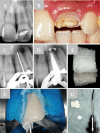Endodontic Management of Open Apex Teeth Using Lyophilized Collagen Sponge and MTA Cement: Report of Two Cases
- PMID: 28512495
- PMCID: PMC5431724
- DOI: 10.22037/iej.2017.48
Endodontic Management of Open Apex Teeth Using Lyophilized Collagen Sponge and MTA Cement: Report of Two Cases
Abstract
Teeth with open apices, such as in immature teeth or those with apical root resorption are clinical cases with difficult immediate resolution. With the use of mineral trioxide aggregate (MTA) in dentistry, it was possible to optimize the treatment time of these cases by immediate placement of apical plug and the root canal filling. However, some negative effects can occur if MTA is extruded beyond the apex. To avoid this accident, it has been recommended to use of an apical matrix prior to placement of MTA. This study reports two clinical cases of apical plug placement in teeth with pulp necrosis and open apices. One case had an immature apex due to dental trauma and the other case had apical resorption due to the presence of endodontic infection in the root canal. MTA apical plug with approximately 4 mm thickness, was placed in the apical zone of the root and immediately the canal was obturated with gutta-percha and endodontic sealer. Follow-up evaluations showed clinical and radiographic evidence of success.
Keywords: Apex; Collagen; Endodontics; Mineral Trioxide Aggregate.
Conflict of interest statement
‘None declared’.
Figures




References
-
- Love RM, Firth N. Histopathological profile of surgically removed persistent periapical radiolucent lesions of endodontic origin. Int Endod J. 2009;42(3):198–202. - PubMed
-
- Parirokh M, Torabinejad M. Mineral trioxide aggregate: a comprehensive literature review--Part III: Clinical applications, drawbacks, and mechanism of action. J Endod. 2010;36(3):400–13. - PubMed
-
- Trope M. Treatment of the immature tooth with a non-vital pulp and apical periodontitis. Dent Clin North Am. 2010;54(2):313–24. - PubMed
-
- Tomson RM, Polycarpou N, Tomson PL. Contemporary obturation of the root canal system. Br Dent J. 2014;216(6):315–22. - PubMed
-
- Chutich MJ, Kaminski EJ, Miller DA, Lautenschlager EP. Risk assessment of the toxicity of solvents of gutta-percha used in endodontic retreatment. J Endod. 1998;24(4):213–6. - PubMed
Publication types
LinkOut - more resources
Full Text Sources
Miscellaneous
